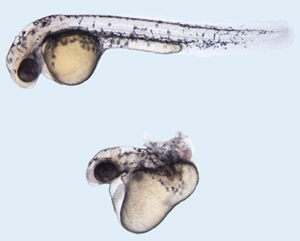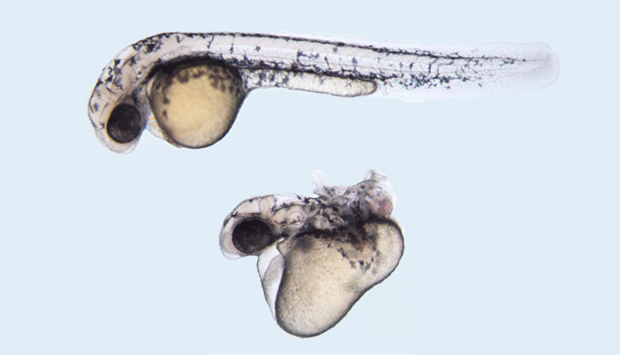
The ELABELA hormone is important for heart development in the early embryo. Zebrafish embryos lacking ELABELA display a range of severe cardiac and other developmental anomalies (bottom) unlike those that express the hormone (top).
© 2013 Elsevier
Hormones — regulatory biochemicals produced by the body — were first identified over 100 years ago. Since then, improvements in researchers’ understanding of the key role that hormones play as chemical messengers in processes such as growth, metabolism and reproduction have enabled some of the most significant medical advances in the twentieth century. The discovery of insulin, for example, led to the first effective treatment for diabetes, and the identification of other hormones, such as cortisol, estrogen, progesterone and testosterone, has resulted in unprecedented advances in human fertility and healthcare.
Now, a team of researchers from the Human Genetics and Embryology Laboratory at A*STAR’s Institute of Medical Biology (IMB) and Institute of Molecular and Cell Biology has uncovered a new hormone that plays an essential role during embryonic heart development. Known as ELABELA, the novel hormone opens up new avenues for the treatment of hypertension, cardiovascular disorders and even HIV infection.
In addition to being a breakthrough for biomedicine, the team’s discovery highlights the importance of carefully decrypting sequenced genomes for possible hidden gems. “Although the human genome was completely sequenced and assembled a decade ago, it is bewildering that hitherto unknown hormones are still being discovered,” says Bruno Reversade, the senior principal investigator at the IMB who led the research team.
Located on human chromosome 4, the gene ELABELA encodes a small secreted peptide hormone consisting of just 32 amino acids. Reversade and his team determined that in zebrafish lacking the ELABELA hormone, embryonic heart development was significantly impeded or, in some cases, stopped completely (see image) — a finding that has since been replicated by researchers at Harvard University in the United States.
Reversade’s team showed that the ELABELA hormone binds to a specific protein found on the surface of cells known as the apelin receptor. Prior to the finding, scientists thought that the apelin receptor could only be activated by the APELIN hormone, which plays multiple roles in the body, influencing, among other essential metabolic functions: myocardial contractility (the intrinsic ability of the heart to contract); the regulation of blood pressure, water and food intake; the release of hormones from the pituitary gland; and bone development.
So far, the team has demonstrated that ELABELA is present in human embryonic stem cells and is also expressed in the adult human prostate and kidney. The researchers’ next step will be to investigate ELABELA’s role in a wider range of organs and tissues. If ELABELA is shown to signal through the apelin receptor in adults as well, the newly discovered hormone could have beneficial effects similar to those of APELIN. The hormone may even block HIV entry to the cell since the apelin receptor is one gateway for viral entry into human cells.
“This discovery shows great promise for the development of targeted therapies for heart disease and blood pressure control in the future,” notes Birgit Lane, executive director of the IMB. “It is an excellent example of how basic research can lead to surprising and unexpected findings that may change and refine medical practice.”
About the Institute of Medical Biology
The Institute of Medical Biology (IMB) is one of the Biomedical Sciences Institutes of the Agency for Science, Technology and Research (A*STAR). It was formed in 2007, with a mission to study mechanisms of human disease in order to discover new and effective therapeutic strategies for improved quality of life. The IMB has 20 research teams working in three primary focus areas: stem cells, genetic disease and skin biology. The teams work closely with clinical collaborators as well as industry partners to target the challenging interface between basic science and clinical medicine. The IMB’s strategic research topics are targeted at translational research to understand the mechanisms of human disease so as to identify new strategies for disease amelioration, cure and eradication, and to improve health and wellbeing. Since 2011, the IMB has also hosted the inter-research institute Skin Biology Cluster Platform and leads major strategic funding programs in rare genetic diseases and in skin biology. In 2013, the IMB became a founding institute of the Skin Research Institute of Singapore.
About the Institute of Molecular and Cell Biology
The A*STAR Institute of Molecular and Cell Biology (IMCB) was established in 1987 at the National University of Singapore before becoming an autonomous research institute of A*STAR and moving to Biopolis in 2004. The IMCB strives to maintain the scientific excellence of principal investigator-driven research and at the same time aims to promote collaborative team-based projects of medical and industrial relevance. Funded primarily by the A*STAR Biomedical Research Council, the IMCB’s research activities focus on four major fields: animal models of development and disease, cancer genetics and therapeutics, cell biology in health and disease, and structural biology and drug discovery.




